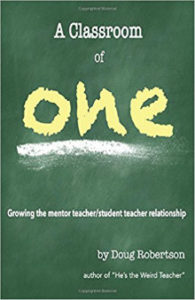How and Why to Mentor Student Teachers
A Classroom of One: Growing the Mentor Teacher/Student Teacher Relationship
By Doug Robertson
(Y42K Publishing, 2017 – Learn more)
 Reviewed by Rita Platt
Reviewed by Rita Platt
I am a pebble in the pond of my student’s lives. By taking a student teacher, I am widening my ripples, as well as throwing another pebble into the pond. I’ve never expected a student teacher to teach my way. But I do expect them to internalize the philosophies of joy, creativity, excitement, and leaping after ideas with wild abandon into their own practice. I want to help student teachers learn to make their own ripples (Robertson, p. 14).
Almost all teachers have either had a mentor teacher or been a mentor teacher. Those of us who have had the responsibility of mentoring a student teacher know that the learning in these relationships is reciprocal and that the many ripples that emanate from them are of great benefit to students, teachers, and the school as a whole. But having a student teacher or being a student teacher can be hard.
 Sadly, while the education publishing industry overflows with new books, there is precious little guidance offered to build mutually satisfying mentor teacher/student teacher relationships.
Sadly, while the education publishing industry overflows with new books, there is precious little guidance offered to build mutually satisfying mentor teacher/student teacher relationships.
Doug Robertson’s book is the first I’ve read that offers meaningful, practical advice on how to insure that having a student teacher (or being a student teacher) benefits all. Inside, readers will find tips on many aspects of having a student teacher including all of the following:
- Communication between student and mentor teachers
- Helping student teachers dive in and teach
- Observing student teachers
- Organizing a classroom with two teachers
The book is divided into 21 short chapters. Each tackles an aspect of the mentor/mentee relationship or of student teaching in general. What binds the chapters is the notion that teaching and learning go hand in hand and that at all levels – from student, to teacher, to student-teacher – engaging in both aspects is essential to the health of the education profession. Roberts offers passionate, kind, and practical reasons for all experienced teachers to consider working with a novice.
Each chapter is filled with anecdotes, ideas, and practical advice. More importantly, at least to me, each chapter is funny! Robertson has a keen eye for the absurd and has no problem making fun of himself (and everyone else, really). I laughed out loud while reading A Classroom of One, and I learned while laughing. Get a glimpse of the humor from a sampling of the chapter titles below.
- Widening the Scope of Not Sucking (Chapter 6)
- Pet Peeves and Weak Links (Chapter 9)
- I Don’t Know If This Is Good Advice (Chapter 17)
- Get a Haircut and Get a Real Job (Chapter 19)
Frankly, I have not had a student teacher in several years. Partly this is because I am a library media specialist in a rural community far from a university setting. There is not much call for mentor teachers in my neck of the woods. But more so because having a student teacher is hard. It is a ton of work and the last time I had one, I didn’t like it.
The truth is, if I tried, I could find new teachers in need of mentoring, and Robertson’s book has convinced me that I should. Even if I don’t, I thoroughly enjoyed reading A Classroom of One. The thinking it inspired will serve me well in any mentoring relationship.
[Note: I previously reviewed this book on Amazon.]
Rita Platt (@ritaplatt) is a National Board Certified teacher with master’s degrees in reading, library, and leadership. Her experience includes teaching learners in remote Alaskan villages, inner cities, and rural communities. She currently is a teacher-librarian, teaches graduate courses for the Professional Development Institute, writes for We Teach We Learn, and blogs for MiddleWeb.

































